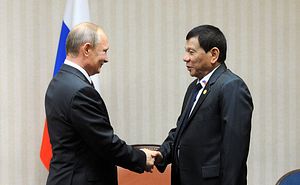Over the weekend, a Philippine Navy vessel completed its first-ever port visit to Russia. The visit spotlighted the ongoing activity within the development of Russia-Philippine defense ties under Philippine President Rodrigo Duterte’s perceived “pivot” to Russia as part of his wider independent foreign policy.
As I have observed previously in these pages and elsewhere, one of the consequences of Duterte’s so-called independent foreign policy, which seeks to boost the country’s outreach with countries like China and Russia, has been the slow but sure development of Russia-Philippine defense relations, despite the challenges that still exist. That includes the maritime realm, where interactions have included visits by Russian vessels to the Philippines and talk about Moscow providing some maritime-related equipment and expertise (See: “What’s Next for Russia-Philippines Maritime Ties?”).
In that wider context, one of the developments that has been in the works has been a Philippine Navy ship making the first-ever port visit to Vladivostok in Russia. In late September, the Philippine Navy strategic sealift vessel BRP Tarlac, with 440 officers and a helicopter detachment on board, left Pier 13, Manila South Harbor for Russia for the trip, which had been couched in terms of a reciprocation for the visits of Russian warships to the Philippines.
Over the past week, we have seen the naval visit play out following weeks of reporting about the interactions and its wider significance for the development of Russia-Philippines ties. As anticipated, the historic port visit began on October 1 and ended on October 6.
The range of interactions had been forecast to be quite wide – Philippine officials had said before the visit that it would include visits to Russian defense facilities, sports and cross-cultural activities, and sea sub-phase exercise in the waters off of Vladivostok. And they largely took place as expected, beginning with a welcome ceremony for Philippine personnel following their arrival in Vladivostok, which was attended by Russian and Philippine contingents and included Philippine Ambassador to Russia Carlos Sorreta and Defense Armed Forces Attaché Col. Dennis Francis V. Pastor.
There were also specific engagements within this list that made the headlines as well in terms of official interactions between Philippine and Russian officials and personnel. One of these was the opportunity for Philippine personnel to see firsthand a Russian diesel-electric submarine, the Komsomolsk-on-Amur. The opportunity, which was at the invitation of the Russian Pacific Fleet and with the submarine positioned near where the BRP Tarlac was docked, saw a select contingent of Philippine personnel witness a demonstration of its capabilities along with a briefing.
In his public remarks, Naval Task Force 87 head Captain Florante Gagua framed the overall visit in term of the broader relationship. In a statement, he said the development was a “great platform” to advance Russian-Philippine navy ties and also Manila’s wider approach to strengthen partners with other navies to address common challenges such as maritime security and promote wider peace and stability.
To be sure, this interaction is just one within the development of defense ties between Russia and the Philippines, and this aspect of ties still remains quite new and basic in spite of the hype that individual events produce. But that should not detract from the limited progress still being made, and the significance both sides are attaching to individual developments within that.
































